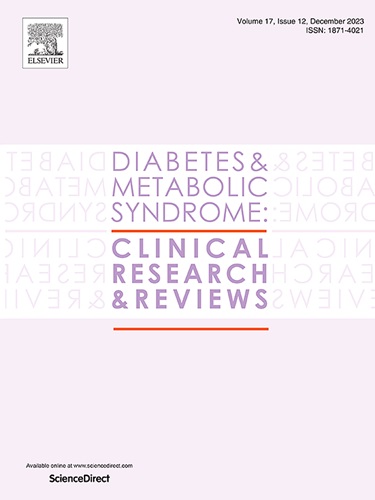频率节律性电调制系统(FREMS)治疗糖尿病神经病变的疗效:随机对照试验的系统回顾和荟萃分析
IF 3.4
Q1 ENDOCRINOLOGY & METABOLISM
Diabetes & Metabolic Syndrome-Clinical Research & Reviews
Pub Date : 2025-03-01
DOI:10.1016/j.dsx.2025.103223
引用次数: 0
摘要
疼痛性糖尿病周围神经病变(DPN)是糖尿病的一种衰弱性并发症,治疗选择有限。频率节律电调制系统(FREMS)是一种非侵入性电疗,在症状治疗中显示出前景。方法检索PubMed、Scopus、Embase等数据库至2024年10月。纳入随机对照试验(RCTs),将成年DPN患者的FREMS与对照组进行比较。提取视觉模拟评分(VAS)和神经传导数据。95%置信区间(ci)的标准化平均差异(SMDs)使用随机效应模型进行汇总。偏倚风险采用RoB 2进行评估。异质性通过I2统计量化,并进行敏感性分析和发表偏倚评价。结果共纳入5项随机对照试验(rct),共333名受试者。meta分析显示,FREMS显著降低了治疗后(SMD -0.56, 95% CI -0.82至- 0.29,I2 = 4%)和随访时(SMD -0.47, 95% CI -0.73至- 0.21,I2 = 0%)的日间VAS疼痛评分。夜间VAS疼痛评分在治疗后(SMD -0.54, 95% CI -0.80至- 0.27,I2 = 44%)和随访时(SMD -0.38, 95% CI -0.65至- 0.12,I2 = 1%)也有所改善。FREMS改善运动神经传导,但对感觉传导和微血管血流无影响。结论frems可有效减轻DPN疼痛,具有持续的疗效和良好的安全性。进一步的研究应使治疗方案标准化,并评估临床整合的长期结果。本文章由计算机程序翻译,如有差异,请以英文原文为准。
Efficacy of Frequency Rhythmic Electrical Modulated System (FREMS) in the treatment of diabetic neuropathy: A systematic review and meta-analysis of randomized controlled trials
Background
Painful diabetic peripheral neuropathy (DPN) is a debilitating complication of diabetes with limited treatment options. Frequency Rhythmic Electrical Modulated System (FREMS), a non-invasive electrotherapy, has shown promise in symptom management.
Methods
Databases, including PubMed, Scopus, and Embase were searched until October 2024. Randomized controlled trials (RCTs) involving adults with DPN comparing FREMS with control were included. Data on Visual Analog Scale (VAS) scores and nerve conduction were extracted. Standardized mean differences (SMDs) with 95 % confidence intervals (CIs) were pooled using random-effects models. Risk of bias was assessed using RoB 2. Heterogeneity was quantified via I2 statistics, with sensitivity analyses and publication bias evaluation.
Results
Five RCTs (333 participants) were included. Meta-analysis indicated that FREMS significantly reduced daytime VAS pain scores post-treatment (SMD -0.56, 95 % CI -0.82 to −0.29, I2 = 4 %) and at follow-up (SMD -0.47, 95 % CI -0.73 to −0.21, I2 = 0 %). Night-time VAS pain scores also improved post-treatment (SMD -0.54, 95 % CI -0.80 to −0.27, I2 = 44 %) and at follow-up (SMD -0.38, 95 % CI -0.65 to −0.12, I2 = 1 %). FREMS improved motor nerve conduction but showed no effect on sensory conduction or microvascular blood flow.
Conclusion
FREMS effectively reduces DPN pain with sustained benefits and a favorable safety profile. Further research should standardize treatment protocols and assess long-term outcomes for clinical integration.
求助全文
通过发布文献求助,成功后即可免费获取论文全文。
去求助
来源期刊

Diabetes & Metabolic Syndrome-Clinical Research & Reviews
ENDOCRINOLOGY & METABOLISM-
CiteScore
22.90
自引率
2.00%
发文量
248
审稿时长
51 days
期刊介绍:
Diabetes and Metabolic Syndrome: Clinical Research and Reviews is the official journal of DiabetesIndia. It aims to provide a global platform for healthcare professionals, diabetes educators, and other stakeholders to submit their research on diabetes care.
Types of Publications:
Diabetes and Metabolic Syndrome: Clinical Research and Reviews publishes peer-reviewed original articles, reviews, short communications, case reports, letters to the Editor, and expert comments. Reviews and mini-reviews are particularly welcomed for areas within endocrinology undergoing rapid changes.
 求助内容:
求助内容: 应助结果提醒方式:
应助结果提醒方式:


